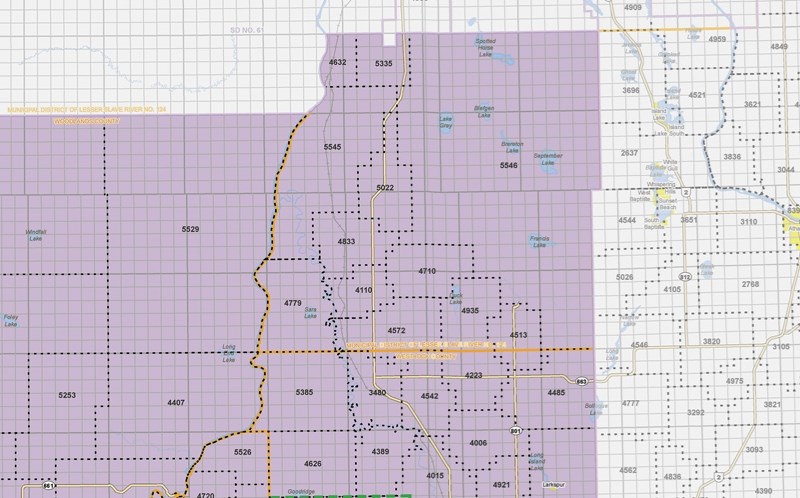Representatives of the MD Lesser Slave River voiced their anger over bus rides lasting over one hour — something they been previously assured wouldn’t happen — during a meeting with Pembina Hills Public Schools trustees.
Reeve Murray Kerik attended the Jan. 8 meeting at R.F. Staples School along with two other councillors. Representing Pembina Hills were board chair Jennifer Tuininga and vice-chair Jackie Comeau.
Pembina Hills’ northern boundary extends partly into the MD of Lesser Slave River No. 124, covering communities like Flatbush and Chisholm. Many of the students living in those areas previously attended W.R. Frose School in Fawcett. However, W.R. Frose was closed along with Jarvie School at the end of the 2013-2014 school year and they were amalgamated along with students from Dapp into the new Pembina North Community School.
The meeting was mostly an opportunity for the Lesser Slave River councillors to voice their complaints over previous promises made.
Kerik said they held numerous meetings with trustees and Pembina Hills administration where they promised bus rides down to the new school at Dapp wouldn’t last more than an hour.
“We told them at the time that they couldn’t do it,” said Kerik, adding that former Westlock County reeve Charles Navratil had also voiced his doubts about Pembina Hills’ ability to limit bus ride times to 60 minutes.
Nonetheless, Kerik said their concerns were glossed over by Pembina Hills reps stating they had computer modeled and drove the routes.
Today, the longest bus ride down to Pembina North runs about an hour and 20 minutes, he said, noting his own grandchildren, who are five and seven years old respectively, ride the bus for about an hour and 15 minutes.
“We were given … what we feel is a lot of misinformation at those sessions. Either that, or somebody’s inept at whatever they do,” he said.
Kerik said about 57 children live in the south end of the MD and are bussed south, though he couldn’t say how many live in the north end of Westlock County.
Some go to Pembina North Community School, but some are bussed down to Westlock to attend St. Mary School, or R.F. Staples School.
He indicated some parents also opted just to drive their kids to Westlock Elementary School because they’re headed in that direction for work anyway.
Kerik said the misinformation has caused a lot of hard feelings in regards to Pembina Hills and has probably killed any chance of families moved into the north end of Westlock County, or the south end the MD of Lesser Slave River.
“The one school that should have been saved is gone, and the other one’s been given away,” he said. “Centralization seems to be a monster that bites everybody.”
In a separate interview regarding the meeting, Tuininga confirmed students in that northern area are experiencing longer bus rides because of the distance from PNCS.
“We have some of those same issues in other areas of the division, depending on where people live and where the school is,” she said.
“There’s no way around some of those challenges, but we certainly try to make sure that we have … that we’ve done our best with route times and number of stops and number of bus routes.”
Kerik did acknowledge that Pembina Hills is certainly trying to serve the children who live up in the northern area.
“They put four runs on for 57 kids … that’s a lot of buses for that few kids,” he said. “You have to give them a little credit. They are trying, after the fact.”
He also acknowledged that there is little to be done, as there is no way to shorten that distance and it’s very unlikely a new school will be built in that area.
“There’s nothing we can do about it now, except learn to work with it and try to make things better,” he said.
Tuininga said the meeting was also an opportunity to talk about some of the different challenges of schooling in rural areas and the different things they can work together on in terms of advocacy for extra funding for transportation or maintenance of school buildings.
“We talked a little bit about what we’re doing as school boards and municipalities to try and make sure that we’re getting rural issues out there in the public, as well as being able to understand some of the challenges that are occurring in our urban areas as well,” she said.
“It was just a time to kind of get together in person, learn a little bit about what each of us are doing, and talk a little bit about how maybe we can move forward and continue those conversations and relationships.”
Given that they have four new trustees and many neighbouring municipalities have new councillors, Tuininga said the board will look for opportunities to continue to have face-to-face meetings and discuss different issues that come to light.
Although they don’t have a lot of confidence in Pembina Hills, Kerik said his fellow councillors are willing to give them another chance and see if they can work together on a few things.
“You always got to deal with the future,” Kerik added.



